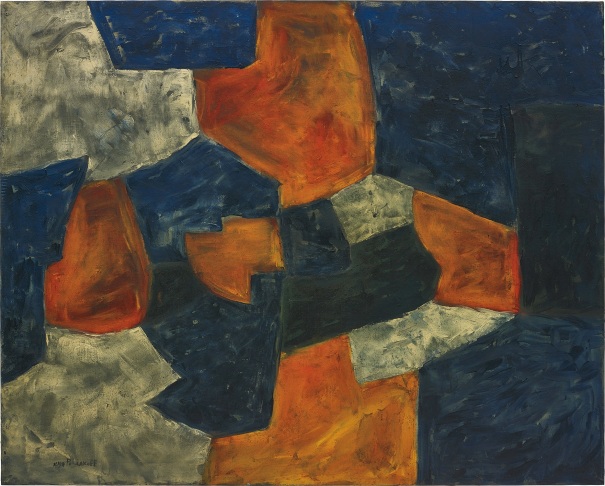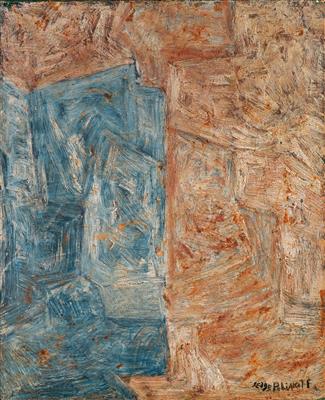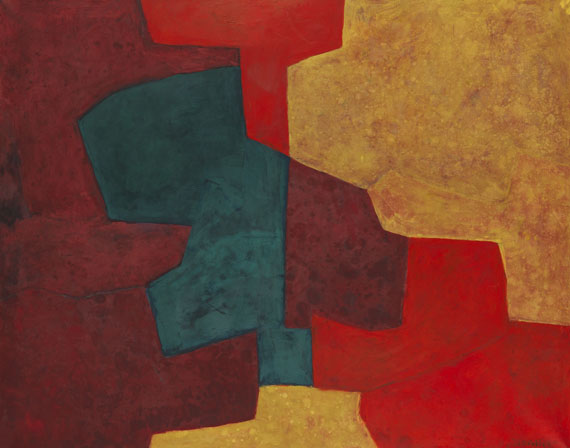Gouache on paper - Sig. - 61,5 x 46,5 cm
Literature "Catalogue raisonné de l'oeuvre de Serge Poliakoff" Alexis Poliakoff, Vol. II 1955-1958, Ed. Galerie Française, Munich 2010, nr. 58-114, p. 261 Included in the Serge Poliakoff Archives as number nr. 858029 Provenance Yonetsu Gal., Tokyo auction Sotheby's, London, 22 February 1990 Gal. Pascal Lansberg, Paris Serge Poliakoff - Plastic poems Poliakoff was born as the 13th of 14 children in a family of horse breeders. As a young man, driven away by the Russian Revolution, he decided to follow his aunt Nastia, an internationally renowned gypsy music performer, abroad. In the following years he had a nomadic existence that brought him to Constantinople, Sofia, Belgrade, Vienna and Paris, among others. He was a particularly talented musician and earned his living mainly by playing guitar and performing Russian cabaret. He painted every day, but until the early 1950s, Poliakoff lived almost entirely from the income of his musical talent. Like a true bohemian, he played music until the early hours, slept late into the afternoon and painted until the evening. The income enabled him to support and finance his burgeoning painting career and growing family. When he meets Wassily Kandinsky and Robert and Sonia Delaunay in 1937, he abandons the academic and traditional style of painting he has maintained until then. He exchanges the figurative for the abstract and gradually his own geometric vocabulary takes shape. His painting style is defined by various color planes that fall together like a puzzle. They relate to each other as a kind of dialogue and have an almost musical continuity. His artworks are, as the artist likes to say, "Plastic poems". They distance themselves from every figurative reference and symbolic interpretation and the atmosphere is poetic and somewhat organic. The compositions have no depth or perspective, but create their own space. The gesture of painting doesn't play an important role here, in contrast to Poliakoff's abstract expressionist contemporaries in America. After he has found his own style, he builds up a large repertoire. By mixing and combining a small number of basic tones, his chromatic canon has an inexhaustible richness. He practiced this style until the end of his career, without falling into repetition or stagnation. He is therefore regarded as one of the most important post-war abstract artists.
Gouache on paper - Sig. - 61,5 x 46,5 cm
Literature "Catalogue raisonné de l'oeuvre de Serge Poliakoff" Alexis Poliakoff, Vol. II 1955-1958, Ed. Galerie Française, Munich 2010, nr. 58-114, p. 261 Included in the Serge Poliakoff Archives as number nr. 858029 Provenance Yonetsu Gal., Tokyo auction Sotheby's, London, 22 February 1990 Gal. Pascal Lansberg, Paris Serge Poliakoff - Plastic poems Poliakoff was born as the 13th of 14 children in a family of horse breeders. As a young man, driven away by the Russian Revolution, he decided to follow his aunt Nastia, an internationally renowned gypsy music performer, abroad. In the following years he had a nomadic existence that brought him to Constantinople, Sofia, Belgrade, Vienna and Paris, among others. He was a particularly talented musician and earned his living mainly by playing guitar and performing Russian cabaret. He painted every day, but until the early 1950s, Poliakoff lived almost entirely from the income of his musical talent. Like a true bohemian, he played music until the early hours, slept late into the afternoon and painted until the evening. The income enabled him to support and finance his burgeoning painting career and growing family. When he meets Wassily Kandinsky and Robert and Sonia Delaunay in 1937, he abandons the academic and traditional style of painting he has maintained until then. He exchanges the figurative for the abstract and gradually his own geometric vocabulary takes shape. His painting style is defined by various color planes that fall together like a puzzle. They relate to each other as a kind of dialogue and have an almost musical continuity. His artworks are, as the artist likes to say, "Plastic poems". They distance themselves from every figurative reference and symbolic interpretation and the atmosphere is poetic and somewhat organic. The compositions have no depth or perspective, but create their own space. The gesture of painting doesn't play an important role here, in contrast to Poliakoff's abstract expressionist contemporaries in America. After he has found his own style, he builds up a large repertoire. By mixing and combining a small number of basic tones, his chromatic canon has an inexhaustible richness. He practiced this style until the end of his career, without falling into repetition or stagnation. He is therefore regarded as one of the most important post-war abstract artists.
.jpg?w=400?width=1600&quality=70)
.jpg?w=400?width=1600&quality=70)













Testen Sie LotSearch und seine Premium-Features 7 Tage - ohne Kosten!
Lassen Sie sich automatisch über neue Objekte in kommenden Auktionen benachrichtigen.
Suchauftrag anlegen